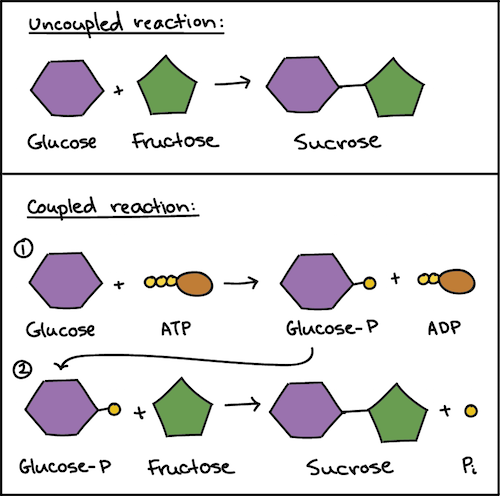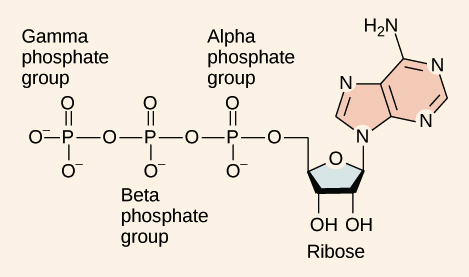Explain Why the Phosphate End of Atp Stores Energy
ATP stands for adenosine tri-phosphate and the energy is mostly stored in the third phosphate bond. When this occurs ATP Adenosine triphosphate is converted into ADP adenosine diphosphate it is the form of the nucleotide having only two phosphates.

Atp Cycle And Reaction Coupling Energy Article Khan Academy
The structure of ATP is that of an RNA nucleotide with three phosphates attached.

. Each of the phosphate groups in negatively charged. The purpose of ATP is to store energy. Adenosine triphosphate also known as ATP is a molecule that carries energy within cells.
At the end or lowest energy level of the electron transport chain the hydride ion combines with oxygen and a proton hydrogen ion to form a water molecule. So the energy from cellular respiration is stored in the bond between the 2nd and 3rd phosphate groups of ATP. The purpose of ATP is to store energy.
1 Adenosine triphosphate ATP consists of an adenosine molecule bonded to three phophate groups in a row. All three can be used for energy but energy stored is proportional to the phosphate groups and thus energy storage is in the order ATPADPAMP 1. What is an electron transport chain.
High energy bonds are. Thus the phosphate end of the ATP mol View the full answer. Now its back to being ADP and is ready to store the energy from respiration by bonding with a 3rd.
ATP functions as the energy currency for cells. ATP molecules are largely composed of three essential components. Usually only the outer phosphate group is removed from ATP to yield energy.
Which has more potential energy ATP or ADP. Explain why the phosphate end of ATP stores potential energy. Substrate level phosphorylation is the process by which ATP is produced from the transfer of a phosphate group from a substrate molecule in a metabolic pathway.
In general the main energy source for cellular metabolism is glucose which is catabolized in the three subsequent processes. Each of the phosphate groups is negatively charged. Terms in this set 11 Explain why the phosphate end of ATP stores potential energy.
These negative repel each other and so they would have less energy if they were further apart. There are a large range of different ATP-binding proteins in the cell and the precise details of the. Among them ATP is the effective central linkthe exchange coinbetween energy-producing and the energy-demanding processes that effectively involve formation hydrolysis or transfer of the terminal phosphate group.
Adenosine Triphosphate Definition. ATP contains energy in a chemical form stored in the anhydride bond of the terminal γ phosphate. When you take away one phosphate group energy is released because the negative charge between those two is released.
Explain why the phosphate end of ATP stores potential energy. It is the main energy currency of the cell and it is an end product of the processes of photophosphorylation adding a phosphate group to a molecule using energy from light cellular respiration and fermentationAll living things use ATP. It allows the cell to store energy briefly and transport it within the cell to support endergonic chemical reactions.
For phosphorylation as the enzyme transfers a phosphate to other compounds 2. These negatives repel each other and so they would have less energy if they were further apart. Up to 24 cash back 1.
All three of the phosphate groups have a negative charge and since they are all connected to each other by a carbon chain they have more energy because they repel each other. Explain why the phosphate end of ATP stores potential energy. ATP adenosine triphosphate is the energy-carrying molecule used in cells because it can release energy very quickly.
Write the overall reaction for cellular respiration. ATP stands for adenosine tri-phosphate and the energy is mostly stored in the third phosphate bond. If this bond is hydrolysed ie.
During cellular respiration the energy being released helps the ADP molecule bind to another phosphate group. When the cell needs energy to do work ATP loses its 3rd phosphate group releasing energy stored in the bond that the cell can use to do work. The pentose sugar molecule ie.
The reason for this ordering is that the hydrolysis of a pyrophosphate bond is exergonic meaning that it releases energy and thus molecules with 3 pyrophosphate bonds store more energy than those with 2 or 1. Each of the phosphate groups is negatively charged. In a process called cellular respiration chemical energy in food is converted into chemical energy that the cell can use and stores.
Cleaved by a water molecule then the energy can be released. This energy is stored in the bond between the existing phosphate groups and the new phosphate group. As the hydride ion is passed from one enzyme to another in the chain energy is made available to power the formation of ATP from adenosine diphosphate ADP and inorganic phosphate.
Explain why the phosphate end of ATP stores potential energy. These negatives repel each other and so they would have less energy if they were further apart. What atom is known as an electron grabber because it attracts electrons so strongly.
This article guides you to learn about how energy is stored in Adenosine Triphosphate ATP. As ATP is used for energy a phosphate group or two are detached and either ADP or AMP is produced. It uses stored ATP and then forms a net increase in ATP.
Regarding this why is glycolysis described as having an energy investment phase and an energy payoff phase. Energy is released from ATP when the end phosphate is removed. Phosphoanhydride bonds link the terminal phosphates formed by the removal of water between two phosphoric acids or between a carboxylic acid and a phosphoric acid tend to have a large negative AG of hydrolysis and are thus said to be high energy bonds.

Atp Cycle And Reaction Coupling Energy Article Khan Academy
Which Bond Must Break In Atp For Energy To Be Released Quora
0 Response to "Explain Why the Phosphate End of Atp Stores Energy"
Post a Comment